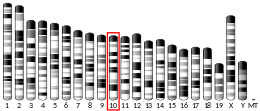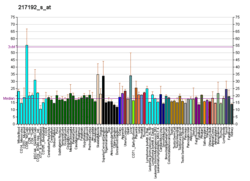PRDM1
PR domain zinc finger protein 1 also known as BLIMP-1 is a protein that in humans is encoded by the PRDM1 gene.[5][6] BLIMP-1 acts as a repressor of beta-interferon (β-IFN) gene expression. The protein binds specifically to the PRDI (positive regulatory domain I element) of the β-IFN gene promoter. Transcription of this gene increases upon virus induction.[6]
Function
The increased expression of the Blimp-1 protein in B lymphocytes, T lymphocytes, NK cell and other immune system cells leads to an immune response through proliferation and differentiation of antibody secreting plasma cells. Blimp-1 is also considered a 'master regulator' of hematopoietic stem cells.[7][8]
Blimp1 (also known as Prdm1), a known transcriptional repressor, has a critical role in the foundation of the mouse germ cell lineage, as its disruption causes a block early in the process of primordial germ cell formation. Blimp1-deficient mutant embryos form a tight cluster of about 20 primordial germ cell-like cells, which fail to show the characteristic migration, proliferation and consistent repression of homeobox genes that normally accompany specification of primordial germ cells. The genetic lineage-tracing experiments indicate that the Blimp1-positive cells originating from the proximal posterior epiblast cells are indeed the lineage-restricted primordial germ cell precursors.[9]
Second cancers after radiation treatment
A genome-wide association study has identified two genetic variations near the PRDM1 gene that predict an increased likelihood of developing a second cancer after radiation treatment for Hodgkin lymphoma.[10]
References
- GRCh38: Ensembl release 89: ENSG00000057657 - Ensembl, May 2017
- GRCm38: Ensembl release 89: ENSMUSG00000038151 - Ensembl, May 2017
- "Human PubMed Reference:". National Center for Biotechnology Information, U.S. National Library of Medicine.
- "Mouse PubMed Reference:". National Center for Biotechnology Information, U.S. National Library of Medicine.
- Keller AD, Maniatis T (May 1991). "Identification and characterization of a novel repressor of beta-interferon gene expression". Genes & Development. 5 (5): 868–79. doi:10.1101/gad.5.5.868. PMID 1851123.
- "Entrez Gene: PRDM1 PR domain containing 1, with ZNF domain".
- Turner CA, Mack DH, Davis MM (Apr 1994). "Blimp-1, a novel zinc finger-containing protein that can drive the maturation of B lymphocytes into immunoglobulin-secreting cells". Cell. 77 (2): 297–306. doi:10.1016/0092-8674(94)90321-2. PMID 8168136.
- Sciammas R, Davis MM (May 2004). "Modular nature of Blimp-1 in the regulation of gene expression during B cell maturation". Journal of Immunology. 172 (9): 5427–40. doi:10.4049/jimmunol.172.9.5427. PMID 15100284.
- Ohinata Y, Payer B, O'Carroll D, Ancelin K, Ono Y, Sano M, Barton SC, Obukhanych T, Nussenzweig M, Tarakhovsky A, Saitou M, Surani MA (Jul 2005). "Blimp1 is a critical determinant of the germ cell lineage in mice". Nature. 436 (7048): 207–213. doi:10.1038/nature03813. PMID 15937476.
- Best T, Li D, Skol AD, Kirchhoff T, Jackson SA, Yasui Y, Bhatia S, Strong LC, Domchek SM, Nathanson KL, Olopade OI, Huang RS, Mack TM, Conti DV, Offit K, Cozen W, Robison LL, Onel K (Aug 2011). "Variants at 6q21 implicate PRDM1 in the etiology of therapy-induced second malignancies after Hodgkin's lymphoma". Nature Medicine. 17 (8): 941–3. doi:10.1038/nm.2407. PMC 3229923. PMID 21785431. Lay summary – University of Chicago Medical Center.
Further reading
- Huang S (Jul 1994). "Blimp-1 is the murine homolog of the human transcriptional repressor PRDI-BF1". Cell. 78 (1): 9. doi:10.1016/0092-8674(94)90565-7. PMID 8033216.
- Mock BA, Liu L, LePaslier D, Huang S (Oct 1996). "The B-lymphocyte maturation promoting transcription factor BLIMP1/PRDI-BF1 maps to D6S447 on human chromosome 6q21-q22.1 and the syntenic region of mouse chromosome 10". Genomics. 37 (1): 24–8. doi:10.1006/geno.1996.0516. PMID 8921366.
- Ren B, Chee KJ, Kim TH, Maniatis T (Jan 1999). "PRDI-BF1/Blimp-1 repression is mediated by corepressors of the Groucho family of proteins". Genes & Development. 13 (1): 125–37. doi:10.1101/gad.13.1.125. PMC 316372. PMID 9887105.
- Angelin-Duclos C, Cattoretti G, Lin KI, Calame K (Nov 2000). "Commitment of B lymphocytes to a plasma cell fate is associated with Blimp-1 expression in vivo". Journal of Immunology. 165 (10): 5462–71. doi:10.4049/jimmunol.165.10.5462. PMID 11067898.
- Gupta S, Anthony A, Pernis AB (May 2001). "Stage-specific modulation of IFN-regulatory factor 4 function by Krüppel-type zinc finger proteins". Journal of Immunology. 166 (10): 6104–11. doi:10.4049/jimmunol.166.10.6104. PMID 11342629.
- Medina F, Segundo C, Campos-Caro A, González-García I, Brieva JA (Mar 2002). "The heterogeneity shown by human plasma cells from tonsil, blood, and bone marrow reveals graded stages of increasing maturity, but local profiles of adhesion molecule expression". Blood. 99 (6): 2154–61. doi:10.1182/blood.V99.6.2154. PMID 11877292.
- Shaffer AL, Lin KI, Kuo TC, Yu X, Hurt EM, Rosenwald A, Giltnane JM, Yang L, Zhao H, Calame K, Staudt LM (Jul 2002). "Blimp-1 orchestrates plasma cell differentiation by extinguishing the mature B cell gene expression program". Immunity. 17 (1): 51–62. doi:10.1016/S1074-7613(02)00335-7. PMID 12150891.
- Vasanwala FH, Kusam S, Toney LM, Dent AL (Aug 2002). "Repression of AP-1 function: a mechanism for the regulation of Blimp-1 expression and B lymphocyte differentiation by the B cell lymphoma-6 protooncogene". Journal of Immunology. 169 (4): 1922–9. doi:10.4049/jimmunol.169.4.1922. PMID 12165517.
- Borson ND, Lacy MQ, Wettstein PJ (Dec 2002). "Altered mRNA expression of Pax5 and Blimp-1 in B cells in multiple myeloma". Blood. 100 (13): 4629–39. doi:10.1182/blood.V100.13.4629. PMID 12453881.
- Györy I, Fejér G, Ghosh N, Seto E, Wright KL (Mar 2003). "Identification of a functionally impaired positive regulatory domain I binding factor 1 transcription repressor in myeloma cell lines". Journal of Immunology. 170 (6): 3125–33. doi:10.4049/jimmunol.170.6.3125. PMID 12626569.
- Gyory I, Wu J, Fejér G, Seto E, Wright KL (Mar 2004). "PRDI-BF1 recruits the histone H3 methyltransferase G9a in transcriptional silencing". Nature Immunology. 5 (3): 299–308. doi:10.1038/ni1046. PMID 14985713.
- Lotz C, Mutallib SA, Oehlrich N, Liewer U, Ferreira EA, Moos M, Hundemer M, Schneider S, Strand S, Huber C, Goldschmidt H, Theobald M (Jul 2005). "Targeting positive regulatory domain I-binding factor 1 and X box-binding protein 1 transcription factors by multiple myeloma-reactive CTL". Journal of Immunology. 175 (2): 1301–9. doi:10.4049/jimmunol.175.2.1301. PMID 16002735.
- Tam W, Gomez M, Chadburn A, Lee JW, Chan WC, Knowles DM (May 2006). "Mutational analysis of PRDM1 indicates a tumor-suppressor role in diffuse large B-cell lymphomas". Blood. 107 (10): 4090–100. doi:10.1182/blood-2005-09-3778. PMID 16424392.
- Pasqualucci L, Compagno M, Houldsworth J, Monti S, Grunn A, Nandula SV, Aster JC, Murty VV, Shipp MA, Dalla-Favera R (Feb 2006). "Inactivation of the PRDM1/BLIMP1 gene in diffuse large B cell lymphoma". The Journal of Experimental Medicine. 203 (2): 311–7. doi:10.1084/jem.20052204. PMC 2118216. PMID 16492805.
- González-García I, Ocaña E, Jiménez-Gómez G, Campos-Caro A, Brieva JA (Apr 2006). "Immunization-induced perturbation of human blood plasma cell pool: progressive maturation, IL-6 responsiveness, and high PRDI-BF1/BLIMP1 expression are critical distinctions between antigen-specific and nonspecific plasma cells". Journal of Immunology. 176 (7): 4042–50. doi:10.4049/jimmunol.176.7.4042. PMID 16547239.
- Garcia JF, Roncador G, García JF, Sánz AI, Maestre L, Lucas E, Montes-Moreno S, Fernandez Victoria R, Martinez-Torrecuadrara JL, Marafioti T, Mason DY, Piris MA (Apr 2006). "PRDM1/BLIMP-1 expression in multiple B and T-cell lymphoma". Haematologica. 91 (4): 467–74. PMID 16585013.
- Lim J, Hao T, Shaw C, Patel AJ, Szabó G, Rual JF, Fisk CJ, Li N, Smolyar A, Hill DE, Barabási AL, Vidal M, Zoghbi HY (May 2006). "A protein-protein interaction network for human inherited ataxias and disorders of Purkinje cell degeneration". Cell. 125 (4): 801–14. doi:10.1016/j.cell.2006.03.032. PMID 16713569.
External links
- PRDM1+protein,+human at the US National Library of Medicine Medical Subject Headings (MeSH)
- FactorBook PRDM1
This article incorporates text from the United States National Library of Medicine, which is in the public domain.




